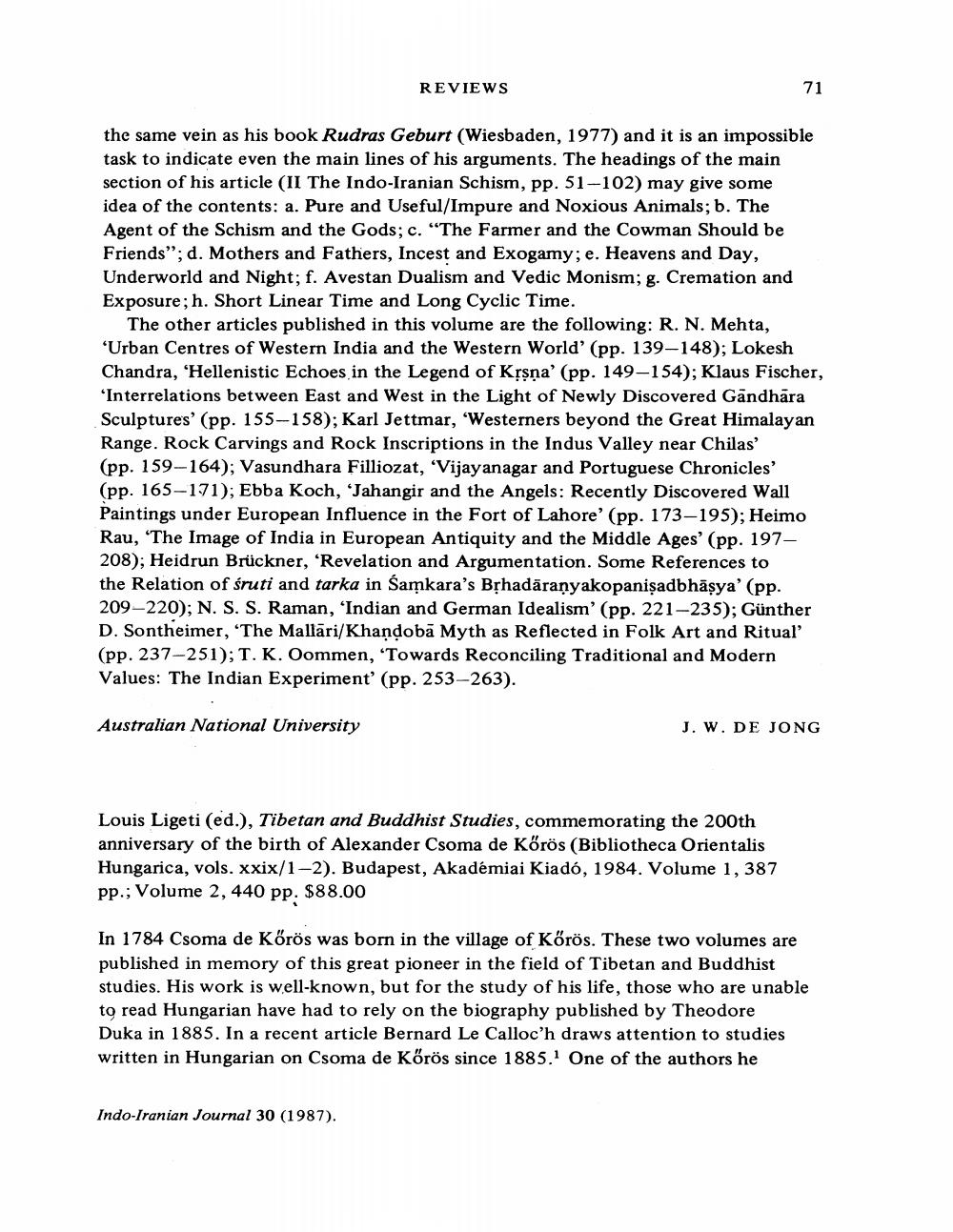Book Title: Book Reviews Author(s): J W De Jong Publisher: J W De Jong View full book textPage 5
________________ REVIEWS 71 the same vein as his book Rudras Geburt (Wiesbaden, 1977) and it is an impossible task to indicate even the main lines of his arguments. The headings of the main section of his article (II The Indo-Iranian Schism, pp. 51-102) may give some idea of the contents: a. Pure and Useful/Impure and Noxious Animals; b. The Agent of the Schism and the Gods; c. "The Farmer and the Cowman Should be Friends"; d. Mothers and Fathers, Incest and Exogamy; e. Heavens and Day, Underworld and Night; f. Avestan Dualism and Vedic Monism; g. Cremation and Exposure; h. Short Linear Time and Long Cyclic Time. The other articles published in this volume are the following: R. N. Mehta, 'Urban Centres of Western India and the Western World' (pp. 139–148); Lokesh Chandra, 'Hellenistic Echoes in the Legend of Krsna' (pp. 149–154); Klaus Fischer, 'Interrelations between East and West in the Light of Newly Discovered Gandhara Sculptures' (pp. 155-158); Karl Jettmar, 'Westerners beyond the Great Himalayan Range. Rock Carvings and Rock Inscriptions in the Indus Valley near Chilas' (pp. 159-164); Vasundhara Filliozat, "Vijayanagar and Portuguese Chronicles' (pp. 165-171); Ebba Koch, Jahangir and the Angels: Recently Discovered Wall Paintings under European Influence in the Fort of Lahore' (pp. 173–195); Heimo Rau, 'The Image of India in European Antiquity and the Middle Ages' (pp. 197208); Heidrun Brückner, 'Revelation and Argumentation. Some References to the Relation of śruti and tarka in Samkara's Bșhadaranyakopanişadbhāşya' (pp. 209-220); N. S. S. Raman, 'Indian and German Idealism' (pp. 221-235); Günther D. Sontheimer, 'The Mallāri/Khandobā Myth as Reflected in Folk Art and Ritual (pp. 237-251); T. K. Oommen, 'Towards Reconciling Traditional and Modern Values: The Indian Experiment' (pp. 253-263). Australian National University J. W. DE JONG Louis Ligeti (ed.), Tibetan and Buddhist Studies, commemorating the 200th anniversary of the birth of Alexander Csoma de Kőrös (Bibliotheca Orientalis Hungarica, vols. xxix/1-2). Budapest, Akadémiai Kiadó, 1984. Volume 1, 387 pp.; Volume 2, 440 pp. $88.00 In 1784 Csoma de Körös was born in the village of Kőrös. These two volumes are published in memory of this great pioneer in the field of Tibetan and Buddhist studies. His work is well-known, but for the study of his life, those who are unable to read Hungarian have had to rely on the biography published by Theodore Duka in 1885. In a recent article Bernard Le Calloc'h draws attention to studies written in Hungarian on Csoma de Körös since 1885.' One of the authors he Indo-Iranian Journal 30 (1987).Page Navigation
1 ... 3 4 5 6 7 8 9 10 11 12 13 14 15 16 17 18 19 20 21 22 23 24 25 26 27 28 29 30 31 32 33 34 35 36 37 38 39 40 41 42 43 44 45 46 47 48
